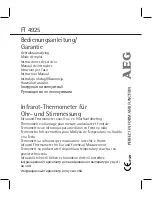
C-3
Appendix: Determining an Unknown Emissivity
C
Method 4
1.
Paint a sample of the object material with flat black lacquer paint.
2.
Set the emissivity to 0.97 and measure and record the temperature
of the painted portion of the sample material - Area
“
A
”
in Figure
C-1. Make sure that the painted area of object material fills the
FOV of the thermometer.
3.
Aim the thermometer at another spot on the target - Area
“
B
”
in
Figure C-1.
4.
Adjust the emissivity of the thermometer until the temperature
reading equals the temperature found in Step 2.
Method 5
1.
Use this method where practical to measure objects at
temperatures above 500°F (260°C).
2. Drill a 1.5
"
(35 mm) diameter hole in a sample of the object
material to a depth of 5
"
(127 mm). This hole closely resembles a
blackbody (refer to Appendix A).
Figure C-2. Determining Emissivity with a Drilled Hole
3.
Set the emissivity to 0.97 and measure and record the temperature
of the hole in the sample material - Area
“
A
”
in Figure C-2. Make
sure that the hole fills the FOV of the thermometer.
4.
Aim the thermometer at another spot on the target as close as
possible to Area
“
A
”
(Area
“
B
”
in Figure C-2).
5. Adjust the emissivity of the thermometer until the temperature
reading equals the temperature found in Step 3.
Drilled out
Area “A” Target
Area “B” Target
Summary of Contents for OS550A
Page 4: ...ii OS550A Series Industrial Infrared Thermometer This page is intentionally blank ...
Page 9: ...vii TABLE OF CONTENTS This page is intentionally blank ...
Page 21: ...Installing the Infrared Thermometer 2 2 8 Notes ...
Page 46: ...3 25 Using the Infrared Thermometer Transmitter 3 Notes ...
Page 47: ...Using the Infrared Thermometer Transmitter 3 3 26 Notes ...
Page 51: ...Laser Sight Accessory 4 4 4 Notes ...
Page 53: ...Maintenance 5 5 2 Notes ...
Page 57: ...Troubleshooting Guide 6 6 4 Notes ...
Page 63: ...1 8 2 Notes Glossary of Key Strokes 8 ...
Page 75: ...I 3 Notes ...






































